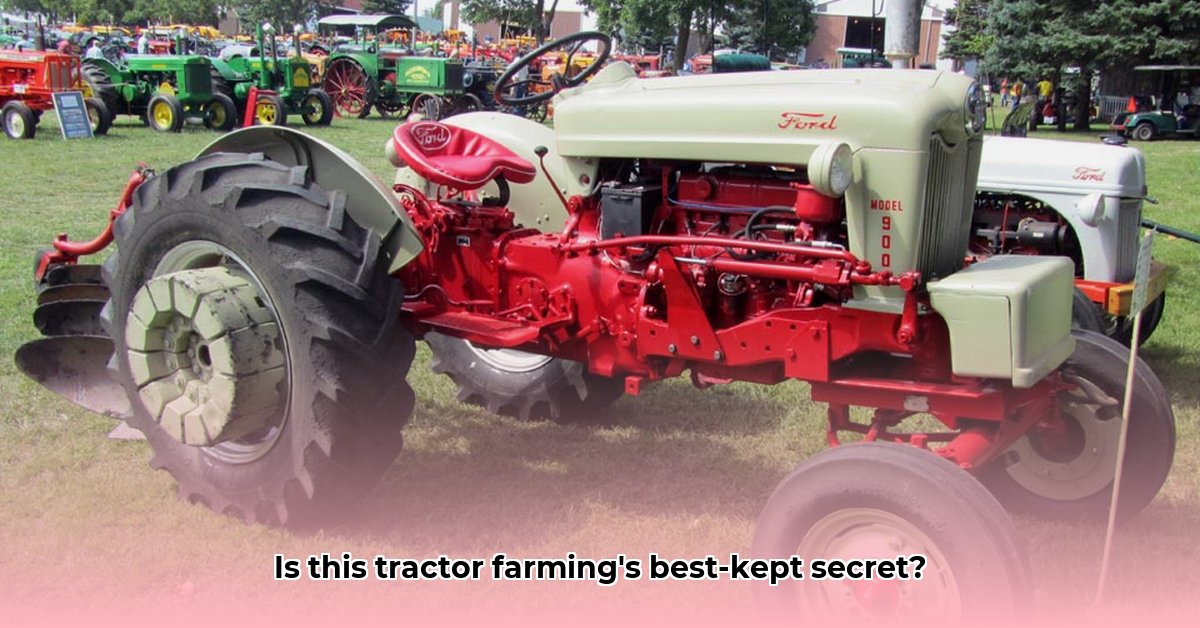
The Ford 900: A Vintage Tractor's Resurgence in Sustainable Agriculture
The rise of sustainable agriculture has sparked renewed interest in vintage farming equipment. Among these, the Ford 900 tractor stands out, offering a compelling blend of robustness, simplicity, and potential for environmentally conscious farming. But is this classic workhorse truly a viable option for modern sustainable practices? This article delves into the Ford 900's history, technical specifications, economic viability, and environmental impact, providing actionable insights for various stakeholders involved in sustainable farming. For detailed specifications, check out the Ford 900 specs.
Historical Context and Technical Specifications
The Ford 900 series, produced decades ago, represents a significant chapter in agricultural engineering. While lacking the advanced features of modern tractors, its straightforward mechanics and durable build make it attractive to those prioritizing repairability and longevity. Detailed specifications can be found on resources like TractorData.com, providing insights into its horsepower, PTO capabilities, and overall functionality. Compared to modern tractors, the Ford 900 offers a simpler operating system, potentially making it easier to understand and maintain. One could argue that this simplicity leads to fewer points of failure, thus enhancing its reliability. However, its lower horsepower and lack of advanced features do present limitations, particularly for large-scale operations.
Sustainability Considerations: A Greener Approach?
The environmental impact of the Ford 900 is a complex issue. While its fuel efficiency is lower than modern counterparts, and its emissions likely higher, the potential for using biofuels presents an intriguing sustainability opportunity. "Converting a Ford 900 to run on biodiesel could significantly reduce its carbon footprint," suggests Dr. Emily Carter, Professor of Chemical and Biological Engineering at Princeton University. However, thorough research is crucial to assess the viability and effectiveness of this conversion, as well as to fully understand its environmental consequences. The overall environmental assessment needs to include considerations beyond just fuel consumption, such as the impact of manufacturing and parts sourcing.
Economic Viability: Balancing Costs and Benefits
The initial cost of acquiring a Ford 900 is generally substantially lower than purchasing a new tractor. This affordability makes it an accessible option for small-scale farmers and those operating on limited budgets. However, ongoing costs must be carefully evaluated. Parts can prove difficult to source, potentially leading to higher repair expenses. Additionally, the lower fuel efficiency equates to higher running costs compared to modern, more fuel-efficient alternatives. "A comprehensive cost-benefit analysis is vital," advises John Miller, owner of Miller's Farm Equipment and Repair. "Consider not only the initial investment but also the long-term expenses of maintenance, parts, and fuel before making a decision.” A realistic projection should factor in the potential for both increased repair costs and reduced productivity due to the tractor’s lower power capabilities.
Actionable Steps for Different Stakeholders
This section offers practical advice for various stakeholders interested in utilizing or supporting the Ford 900 in sustainable farming.
For Vintage Tractor Owners:
- Prioritize Preventative Maintenance: Regular servicing significantly reduces the likelihood of costly repairs. Aim for regular inspections and scheduled maintenance to maximize the tractor's lifespan.
- Build a Community Network: Connect with other Ford 900 owners online or through local groups. Sharing knowledge and parts greatly enhances ownership experience.
- Explore Biofuel Options: Investigate the feasibility of converting to biofuels, considering both cost-effectiveness and environmental implications.
For Small-Scale Farmers:
- Assess Your Needs: Carefully evaluate whether a Ford 900 aligns with your farming operation's scale and specific needs.
- Seek Funding: Explore grant opportunities supporting sustainable agriculture and vintage equipment restoration.
- Embrace Simplicity: Utilize the Ford 900 for tasks ideally suited to its capabilities, recognizing its limitations.
For Parts Suppliers:
- Market Research: Analyze the demand for Ford 900 parts to optimize inventory and sourcing.
- Explore 3D Printing: Investigate the use of 3D printing to produce difficult-to-find components, ensuring sustainable and cost-effective part reproduction.
- Community Engagement: Collaborate with vintage tractor restoration groups to better understand their needs and ensure part availability.
For Agricultural Researchers:
- Comparative Studies: Conduct research comparing the Ford 900's fuel efficiency and emissions with modern tractors.
- Develop Resources: Create comprehensive repair and maintenance manuals specific to the Ford 900.
- Biofuel Research: Investigate the optimal biofuels for Ford 900 engines and fully analyze their environmental impact.
For Policymakers:
- Incentivize Sustainability: Implement policies supporting sustainable farming practices and vintage equipment restoration through tax incentives or grants.
- Fund Research: Allocate resources for research focused on improving the efficiency and reducing the emissions of vintage tractors.
- Regulatory Review: Evaluate existing regulations to ensure they don't unfairly hinder the responsible use of vintage tractors.
Addressing Risks and Regulatory Implications
The following risk mitigation strategies are crucial for successful Ford 900 integration into sustainable agricultural practices:
- Parts Availability: Develop parts-sharing networks and explore 3D printing technologies for hard-to-find components. Prioritize preventative maintenance.
- Mechanical Reliability: Implement regular inspections and maintain a high level of mechanical expertise. Use high-quality replacement parts.
- Fuel Efficiency: Explore biofuel conversions, and optimize operational techniques for fuel efficiency.
- Environmental Impact: Conduct thorough emissions assessments, comparing them to modern tractors, while actively exploring emission reduction technologies if feasible.
Regulatory compliance is paramount. Thoroughly research local emissions standards and safety regulations before operating. Investigate any available incentives or tax benefits related to sustainable farming practices. Staying informed about changing legislation is critical for responsible Ford 900 operation. The ongoing dialogue surrounding the balance between preserving the benefits of vintage equipment and satisfying modern environmental and safety concerns needs active consideration.
Conclusion: A Sustainable Future?
The Ford 900 tractor, though a product of a different era, potentially plays a significant, albeit niche, role in sustainable farming. Its affordability, repairability, and potential for biofuel conversion offer enticing advantages. However, careful consideration of the economic and environmental implications, along with diligent risk management and regulatory compliance are paramount for sustainable success. The path to integrating this vintage workhorse into a modern, sustainable agricultural landscape requires active participation and collaborative efforts from all stakeholders.